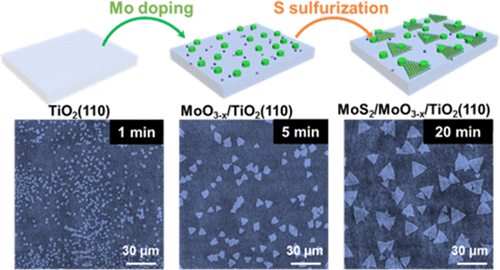当前位置:
X-MOL 学术
›
ACS Appl. Mater. Interfaces
›
论文详情
Our official English website, www.x-mol.net, welcomes your
feedback! (Note: you will need to create a separate account there.)
Mo Doping Assisting the CVD Synthesis of Size-Controlled, Uniformly Distributed Single-Layer MoS2 on Rutile TiO2(110).
ACS Applied Materials & Interfaces ( IF 8.3 ) Pub Date : 2020-07-08 , DOI: 10.1021/acsami.0c07997 Miaomiao Xiang , Huihui Liu , Chenxi Huang , Yue Li , Hualing Zeng , Xiang Shao
ACS Applied Materials & Interfaces ( IF 8.3 ) Pub Date : 2020-07-08 , DOI: 10.1021/acsami.0c07997 Miaomiao Xiang , Huihui Liu , Chenxi Huang , Yue Li , Hualing Zeng , Xiang Shao

|
Molybdenum disulfide (MoS2) has attracted considerable interest due to its superior electronic and optical properties, which have seen promising applications in optoelectronics and catalysis. Chemical vapor deposition (CVD) has been successfully applied in synthesizing MoS2 on various substrates. However, it remains a great challenge to fabricate high-quality MoS2 sheets with well-controlled micro/nano size and homogeneous distribution over the functional substrates such as active metal oxides. Herein, we have developed a two-step synthetic strategy via depositing MoO3 first followed by subsequent vulcanization, to grow single-layer MoS2 on an atomically flat rutile TiO2(110) (r-TiO2(110)) substrate. This method not only very well controls the size as well as the spatial distribution of MoS2 nanosheets over the TiO2 surface but also averts the formation of contaminative species at the heterojunction while maintaining the atomic structure of the substrate surface. The extensive characterizations reveal that the formation of MoS2 derives from the sulfurization of the singly dispersed Mo6+ and Mo5+ species in the surface/subsurface region instead of the aggregated MoO3 patches on top of the TiO2 surface. Such a mechanism may dictate a general way for synthesizing high-quality transition-metal dichalcogenides (TMDs) over a variety of functional substrates.
中文翻译:

Mo掺杂辅助金红石TiO2(110)上CVD合成尺寸控制的,均匀分布的单层MoS2。
二硫化钼(MoS 2)由于其优异的电子和光学性能而引起了人们的极大兴趣,在光电学和催化领域已看到了有希望的应用。化学气相沉积(CVD)已成功应用于在各种基材上合成MoS 2。然而,制造高质量的MoS 2片仍然是一个巨大的挑战,该片具有可控的微米/纳米尺寸,并且在功能性基材(例如活性金属氧化物)上均匀分布。在本文中,我们已经通过沉积的MoO开发了两步合成策略3第一,接着随后的硫化,生长单层的MoS 2上的原子级平坦的金红石型二氧化钛2(110)(R-TIO2(110))基板。该方法不仅很好地控制了TiO 2表面上的MoS 2纳米片的尺寸以及空间分布,而且还避免了异质结处污染物质的形成,同时保持了衬底表面的原子结构。广泛的特征表明,MoS 2的形成源自表面/亚表面区域中单个分散的Mo 6+和Mo 5+物种的硫化,而不是来自TiO 2顶部的聚集MoO 3块。表面。这样的机制可以决定在各种功能性基材上合成高质量过渡金属二卤化物(TMD)的一般方法。
更新日期:2020-07-29
中文翻译:

Mo掺杂辅助金红石TiO2(110)上CVD合成尺寸控制的,均匀分布的单层MoS2。
二硫化钼(MoS 2)由于其优异的电子和光学性能而引起了人们的极大兴趣,在光电学和催化领域已看到了有希望的应用。化学气相沉积(CVD)已成功应用于在各种基材上合成MoS 2。然而,制造高质量的MoS 2片仍然是一个巨大的挑战,该片具有可控的微米/纳米尺寸,并且在功能性基材(例如活性金属氧化物)上均匀分布。在本文中,我们已经通过沉积的MoO开发了两步合成策略3第一,接着随后的硫化,生长单层的MoS 2上的原子级平坦的金红石型二氧化钛2(110)(R-TIO2(110))基板。该方法不仅很好地控制了TiO 2表面上的MoS 2纳米片的尺寸以及空间分布,而且还避免了异质结处污染物质的形成,同时保持了衬底表面的原子结构。广泛的特征表明,MoS 2的形成源自表面/亚表面区域中单个分散的Mo 6+和Mo 5+物种的硫化,而不是来自TiO 2顶部的聚集MoO 3块。表面。这样的机制可以决定在各种功能性基材上合成高质量过渡金属二卤化物(TMD)的一般方法。





















































 京公网安备 11010802027423号
京公网安备 11010802027423号